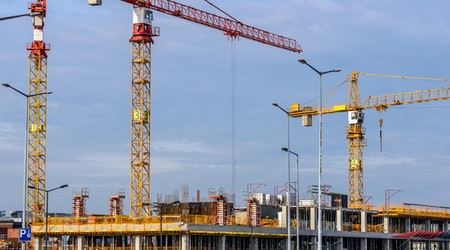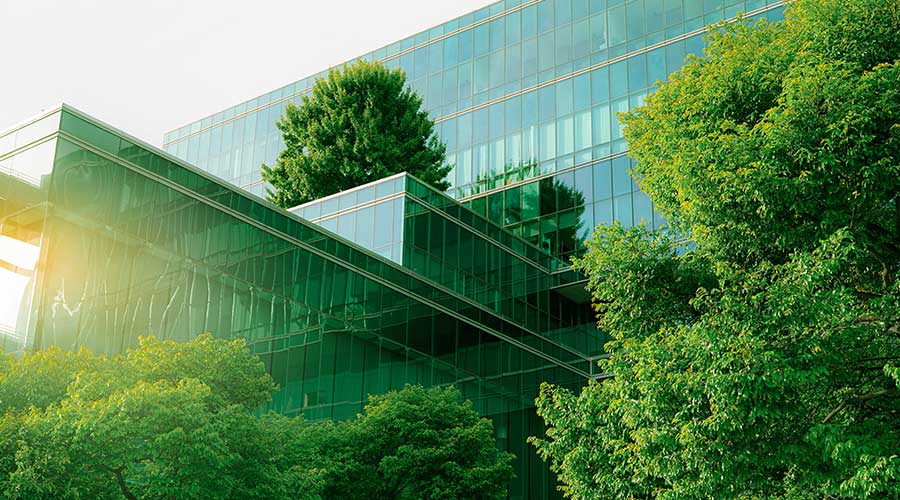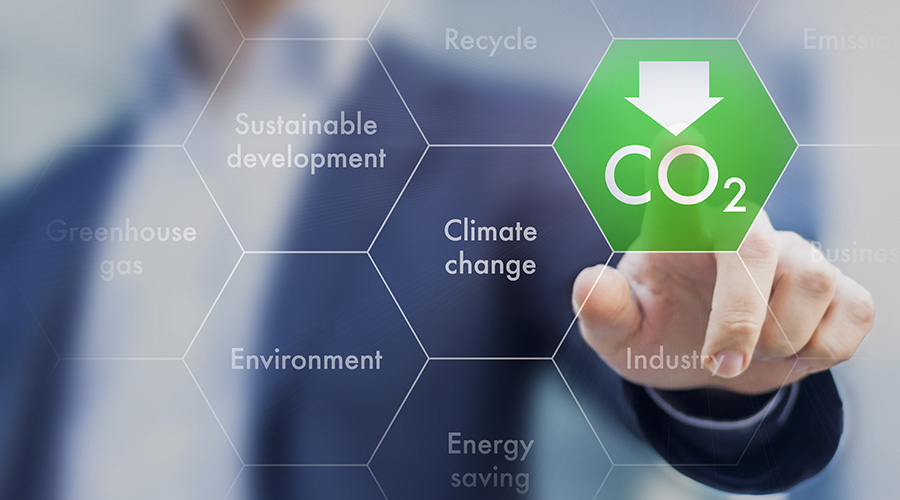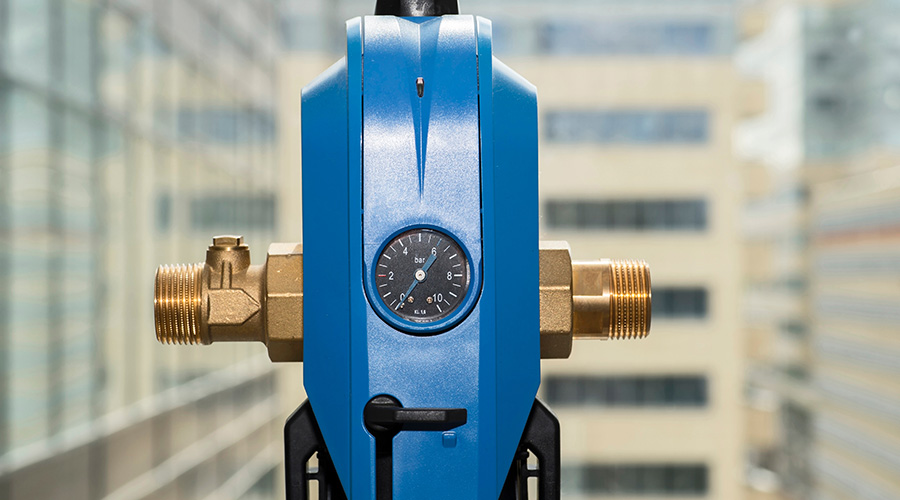Green Building Report
Good Site Selection Engineers Green Building Success
Facility executives interested in green design often overlook a key opportunity to reduce both environmental impact and costs — site planning. Good site planning is as important to achieving a cost-effective green building as nearly any other aspect of the design and construction of the facility. And incorporating LEED principles can cut operations and maintenance costs, aid in improving employee productivity, potentially shorten the design and construction schedule, and cut construction costs, while protecting the environment.
For many green projects, engineers are underused resources in determining the best ways to incorporate green strategies. A LEED-accredited engineer can help maximize the cost and environmental benefits of green projects by considering LEED during the earliest phases of project development such as site selection, site orientation and site design.
A good example of the importance of site planning is how it can affect the HVAC system. In the United States, heating and cooling costs can be reduced by orienting the longest building wall to face south. This maximizes solar energy absorption in the winter and minimizes absorption in the summer. In fact, the California Energy Commission’s Consumer Energy Center estimates total energy use can be reduced by 30 to 40 percent in most parts of the U.S. by designing a building in the right shape, orienting it correctly on the site and carefully placing its windows. Optimizing energy performance through building orientation can earn LEED credits in the Energy and Atmosphere category.
Building orientation can also maximize daylighting potential, which can reduce electricity needs for lighting. The U.S. Department of Energy’s Federal Energy Management Program reports that daylighting can significantly cut energy used for lighting building interiors, sometimes by up to 75 or 80 percent. LEED credits can be earned in the Indoor Environmental Quality category by increasing the amount of natural light which enters a building.
Effective site planning also has some non-energy-related benefits. Light-colored or open-grid pavement can help reduce the urban heat island effect of paved surfaces like roads and driveways. Because the urban heat island effect can drive up building cooling costs, the Department of Energy estimates in its Greening Federal Facilities guide that widespread use of these techniques can reduce air-conditioning costs by 5 to 20 percent. LEED credits are available in the Sustainable Site category for reducing the heat island effect.
Exposure to sunlight can affect the health and productivity of employees. Lockheed Martin reported that after daylighting its facility in Sunnyvale, Calif., the company achieved 15 percent higher worker productivity. According to the Department of Energy’s Greening Federal Facilities guide, a productivity increase of just 1 percent can completely offset a building’s entire energy bill.
Selecting a site that is convenient to walking and biking access can also encourage physical activity. The site can also be designed to accommodate those who walk or bike to work by providing safe, clearly defined and well-lit pathways around the facility, bicycle parking and locking facilities, and showers for bike and pedestrian commuters. LEED credits are awarded for promoting alternative means of transportation.
In addition, air quality on a site can be significantly improved by interspersing oxygen-producing plants throughout the landscaping, which is important because cleaner air will translate into healthier employees. Being careful to select plants that don’t produce pollen can prevent irritating employees’ allergies.
Expediting Matters
A good way to minimize the permitting and regulatory process is to ask a knowledgeable engineer to assist with site selection. Avoiding sites where buildings could have a negative effect on cultural, agricultural, environmental and wildlife resources can save time and money by avoiding the delays and costs associated with the extra permits and approvals. LEED also awards a credit to facilities that incorporate these principles in site selection.
If a site has already been selected that includes these resources, an engineer can carefully orient the building and infrastructure on the site to avoid affecting them negatively, which can reduce permitting and approval requirements. If cultural, agricultural, environmental or wildlife impacts are unavoidable, an engineer can design mitigation measures to help compensate.
In addition, reducing the effect of a development on public infrastructure can reduce public resistance and thus speed the approval process. This can be done by incorporating rainwater harvesting, water reclamation and gray water plumbing systems into the site that reduce a facility’s use of the local water supply. Designing the site to accommodate bike and pedestrian commuters as well as public transportation can reduce the traffic impact on the local roadways. Site features such as planting, grading and ample open space for groundwater recharge can reduce the amount of stormwater that enters the local stormwater system.
LEED credits can also be earned by reducing water use, promoting alternative means of transportation, and managing and treating stormwater.
Reducing Construction Costs
Properly locating a building near existing infrastructure can reduce the need to building costly items, such as lengthy extensions of water and sewer lines and long roads or driveways. Locating projects in developed areas as opposed to greenfields often reduces costs and also will help earn LEED points.
A skilled engineer will be able to design the site to accommodate building needs using the existing grading, natural features and vegetation of the site as much as possible. Reducing site disturbance will minimize excavation and fill costs, as well as meet LEED requirements.
One way to reduce the amount of stormwater piping and detention basins typically constructed is to use smaller, more localized stormwater measures such as bioswales, bioretention, infiltration trenches, porous pavement and vegetated filter strips. Promoting infiltration will also assist in achieving LEED credits.
To achieve the maximum cost-effective benefits a green building can produce, these sustainable design goals need to be considered as early in the planning process as possible. If site selection and planning are already finished before sustainable design goals are considered, completed design work may have to be done again to achieve the fullest potential for cost savings later. Redesign time is expensive.
Another advantage of incorporating sustainable design principles into the planning phase is that it allows an engineer to use existing site features such as grading and landscape to achieve sustainability goals. Use of existing site features can save construction costs that would have resulted from clearing those features and adding new grading or plantings.
Perhaps the greatest cost savings, however, come from time saved by reducing design and construction schedules. By selecting a site that doesn’t disturb natural and cultural resources, and by designing the site to minimize impact on public infrastructure, the delays associated with permitting and approvals can be significantly reduced. Even opening a property one day sooner can mean thousands of dollars in additional profit.
Dennis Reichel is a registered professional engineer and LEED-accredited professional at Herbert, Rowland & Grubic Inc. (HRG) He has experience in the development of commercial and institutional properties.
briefings
IFMA Reports Green Growth
The 2005 Sustainability Study conducted by the International Facility Management Association (IFMA) reveals a trend toward greener commercial buildings.
The study shows that facility management professionals report a continued increase in the use of green building practices, and 70 percent of those responding to the online survey reported implementing green concepts within their facilities.
Using daylight, purchasing recycled office products, conserving water, participating in incentive programs offered by local utilities or state or provincial agencies, and adding environmental criteria to the vendor and product selection process topped the list of the most common green building practices.
Facility managers reported the motivation behind implementing green policies included improved employee health and productivity, cost savings, environmental responsibility, reduced liability and life cycle cost reduction. Of slightly less importance were public opinion and corporate or government mandates.
School Standard
The Greenguard Environmental Institute’s new Standard for Children and Schools sets criteria for manufacturers of building materials, furnishings, finishes and cleaning products to develop products and materials with low VOC emissions for use in school buildings and daycare facilities.
Because schools have up to four times as many occupants as office buildings for the same amount of floor space, and because children are at greater risk to develop health problems because of poor indoor air quality, the standard presents the most rigorous product emissions standards to date, according to Greenguard.
The standard is available for viewing at the Web site.
Not Just Hot Air
Wind power could potentially be more widely used in the United States than previously thought, according to a research project conducted at Stanford University.
In 2000, the researchers used 1,587 surface stations and 97 soundings to map wind power at 80 meters, the hub height of large wind turbines.
The most accurate measurements recorded wind speeds averaging 0.3-0.5 m/s faster than those obtained from previously used methods of collecting elevated data for U.S. windpower maps, according to researchers.
The study found that 21 percent of all stations (and 39 percent of all coastal/offshore stations) are characterized by mean annual speeds greater than or equal to 6.9 m/s at 80 meters, implying that the winds over possibly one fifth of the U.S. are strong enough to provide electric power at a direct cost equal to that of a new natural gas or coal power plant.
Green Power Stars
The EPA has released its quarterly list of the top 25 partners in the Green Power Partnership, which provides assistance and recognition to organizations that choose green power.
The top 25 partners account for a combined 2 million megawatt-hours of electricity annually, which is about 65 percent of the green power commitments made by all partners in the program, according to the EPA.
The top five partners on the October list, ranked in order of megawatt-hours of green power usage: the Air Force, the EPA, Johnson and Johnson, the Department of Energy, and the World Bank.
Six companies listed received 100 percent of their power from green power sources. They were the World Bank, AMD, WhiteWave Foods, the Tower Companies and Hyatt Regency/Reunion and Dallas Airport Hotels.
Wal-Mart Goes Green
Wal-Mart has opened what it dubs an “experimental store” in McKinney, Texas, to learn more about how the company can improve its sustainability. A similar has store also opened in Aurora, Colo.
Among the goals for the 206,000-square-foot McKinney Supercenter:
- Reduce the amount of energy and natural resources needed to operate and maintain the store
- Reduce the amount of grid-purchased energy by using on-site renewable energy strategies
- Reduce the amount of raw materials needed for construction of the facility
To meet the goals, the company is employing a variety of building technologies that have previously not been included in the retailer’s store designs. A cool roof on the building and sun shade over the parking lot are designed to reduce the urban heat island effect.
Pervious pavement in the parking lot is designed to allow water to pass directly through the asphalt into the ground, rather than run into storm sewers. A rainwater collection system is expected to supply the site with up to 95 percent of its irrigation water.
The store also includes a 50-kw wind turbine, which the company estimates will reduce by about 5 percent the amount of energy the store gets from the grid — equivalent to the energy used by 10 average-sized home. Photovoltaic systems mounted on the store’s roof and façade will supply additional power.
Experimental technology includes the use of a bio-fuel boiler that burns discarded cooking oil and used motor oil from the store’s auto center. Waste heat from refrigeration units is used to generate hot water and directed to the store’s radiant floor heating system.
A daylighting system is expected to reduce the store’s lighting needs by about 300,000 kw by dimming lights when there is enough daylight to provide illumination. An average Supercenter consumes 1.5 million killowatts a year in lighting demand, the company says.
Corporate Donations Help University Build Green
Evanston, Ill. The new $30 million Ford Motor Company Engineering Design Center (FMCEDC) is Northwestern University’s first LEED-certified facility, but it portends a much greener future.
With the success of the Ford Center, the university has decided that all future campus buildings will also be LEED certified.
Made possible by a $10 million grant from Ford Motor Co., as well as other corporate donations, construction on the six-story, 84,000-square-foot facility began in 2003. With its use of natural light, gray water, renewable materials and energy, FMCEDC will be a standard for all future construction projects at Northwestern.
Design and construction of the facility presented several challenges, one of which was the site’s limitations. The university’s prized Shakespeare’s Garden, a lush green space that serves as an oasis for students and faculty, was adjacent to the site and many worried that the project would upset or even ruin the sanctuary of flowers, herbs and trees mentioned in Shakespeare’s plays.
Jay Baehr, Northwestern’s senior project manager for facilities, solved the problem by devising a retention basin system that captures rain and discarded gray water from the building. The water is then used to irrigate the Shakespeare Garden.
The impact and potential of natural light were also considered in FMCEDC’s design. Dozens of windows and a vast glass wall that covers much of the facility’s west and south sides provides natural daylight to more than 75 percent of the building’s interior spaces — an impressive percentage considering that two of the facility’s six levels are below grade. An automated solar-tracking system closes window shades in the face of direct sunlight and opens shades in areas away from the sun. In addition, exterior lighting is designed to light the ground, rather than lighting the sky, reducing urban light pollution near Northwestern’s Dearborn Observatory. The building also includes a reflective roof that reduces the urban heat island effect.
Where there aren’t windows, the exterior of the building is predominately exposed concrete with recycled fly-ash content. Throughout the facility, steel and other materials with recyclable content were used.
“I am most satisfied that, through the combined efforts of the entire design and construction team, we were able to achieve the 23.4 percent energy saving over the ASHRAE 90.1-1999 baseline, and that we were able to divert 78 percent of the construction debris from landfills,” says Baehr.
Atlantic Station: Strategic Green Development is One for One
Atlanta A 500,000-square-foot office building at 171 17th Street is the first building to receive LEED certification in midtown Atlanta’s ambitious mixed-use redevelopment project, Atlantic Station. The 138-acre redevelopment, situated on a rehabilitated brownfield site, will eventually include about 12 million square feet of residential, retail and office space, as well as hotels and restaurants. The goal is for every Atlantic Station building to achieve a LEED certification.
The built-to-specification office building, which is 94 percent occupied, received a Silver certification with the pilot version of USGBC’s Core and Shell rating system (LEED-CS). The LEED-CS certification means that when tenants build out their space, they will also have the opportunity to certify their space with the complementary LEED for Commercial Interiors (LEED-CI) rating system.
Atlantic Station’s developer, Jacoby Development, is leading the way in that endeavor, says Brian Leary, vice president of design and development. In addition to plans to certify the space it occupies in the building, the company has worked with the Southface Energy Institute to develop detailed Tenant Design and Construction Guidelines that will assist future tenants in achieving a LEED-CI certification for their spaces as well.
The building’s Silver certification is a result of several green strategies, including a highly reflective roof that will help mitigate Atlanta’s pronounced urban heat island effect, high-performance glass on the building’s exterior, and an efficient chiller plant that will supply the whole site when future buildings are built.
In fact, as the site was planned, the developers incorporated green strategies to make it easier for future buildings to be LEED certified.
These sitewide green strategies include dimming light pollution, reducing the site’s stormwater runoff, building an underground parking structure to be used by the whole site and providing a fleet of electric shuttles that services the entire development and connects to Atlanta’s public transit system. As future buildings are developed, documentation on these sitewide green strategies will be readily available, expediting the LEED certification process.
“We want people to understand that green is part of the way we do business,” says Leary. “When you’re doing something for the first time, it’s tough, but the U.S. Green Building Council was very helpful.”
U.S. Green Building Council
Chair
Kevin Hydes
Keen Engineering
Vice Chair
Tom Paladino
Paladino & Co.
Vice Chair
Zaida Hagar
City of Dallas
 |
Secretary
Gail Vittori
Center for Maximum
Potential Building Systems
Treasurer
James Goldman
Turner Construction Co.
Immediate Past Chair
James E. Hartzfeld
Interface Americas
|
Founder
David A. Gottfried
WorldBuild Technology Inc.
Founder
Michael L. Italiano
Sustainable Products Corp.
President, CEO and
Founding Chairman
S. Richard Fedrizzi
U.S. Green Building Council
1015 18th St., NW Ste. 805
Washington, DC 20036
202/828-7422 |
Web site: www.usgbc.org
e-mail: info@usgbc.org |
Related Topics:













